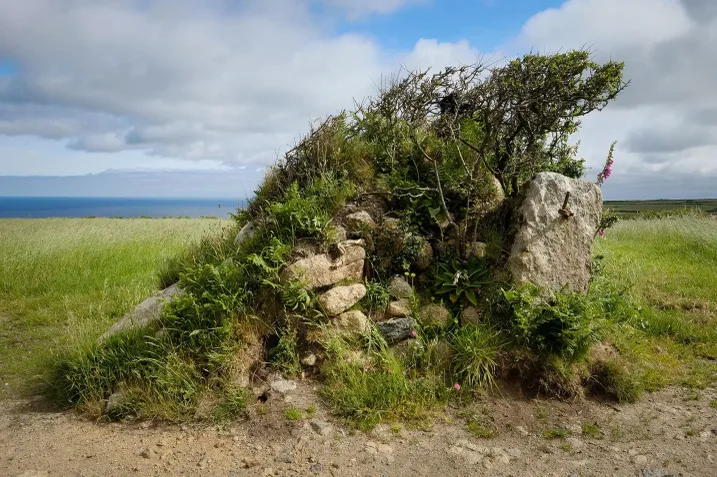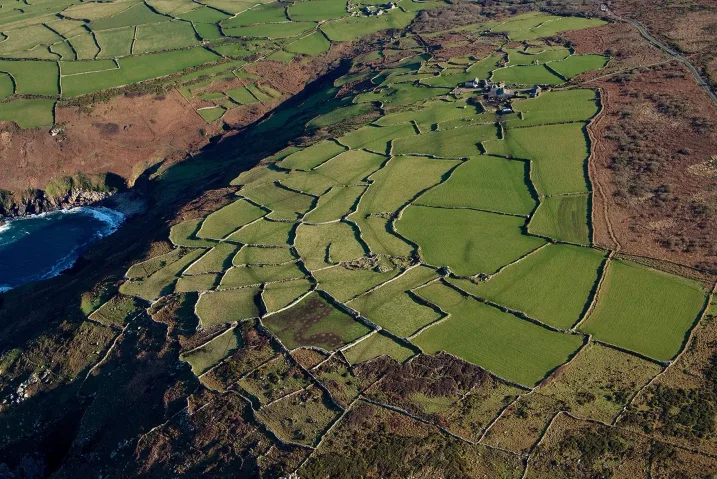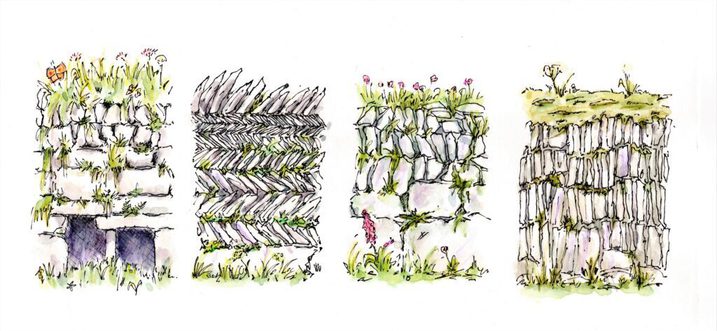In a nutshell...
Funding: Negotiable and scalable*.
Length: Starting ASAP, negotiable length.
Location: Cornwall National Landscape.
Aim: To capture the true ecological and economic value of Cornish Hedges in order to restore and protect them for the future.
Opportunities: Corporate visit days and volunteering.
*subject to additional management fees.

(c) Greg Martin | The side profile of a Cornish Hedge, functioning not only as a boundary but an important ecological resource for biodiversity.
An opportunity steeped in ancient history
If you’ve ever had the pleasure of visiting or living in Cornwall, then you’ll know its twisting, narrow roads lined with high, gorse-laden hedges well.
But did you know that these hedges tell a story that goes back thousands of years?
“Some of Cornwall’s oldest hedges are up to 4,000+ years old, created during the Neolithic as humans transformed from hunter gatherers to cultivation and farming animals.”
Hedges were used, as you would expect, to carve out the landscape for farming and to keep animals secure.
The materials used depended on what was available locally, so hedge design, size, and the type of stone all vary throughout the Cornish landscape.
Cornish Hedges are a window into our earliest land use and relationship with nature, and you can tell their age based on their location and shape.

(c) Cornwall Council Historic Environment Service | An aerial photo showing the layout of ancient Cornish Hedges at Bosigran Farm, Zennor, along with the remains of a prehistoric settlement.
Older hedges tend to be more crooked, winding across the landscape with kinks and missing chunks where they may have been adapted or removed over time. Straighter hedges that line more square fields will be newer, reflecting the more recent agricultural practices.
More than simply an edge marker, Cornish Hedges are ancient monuments with historical, economic, and ecological value.
Of the roughly 30,000 miles of hedges still in Cornwall, over ¾ are considered ‘anciently established’.
Cornish Hedges are a rare instance of major prehistoric remains still in everyday use for their original purpose. Their structure sits on previous land use, sealing it in the ground and preventing casual interference over the millennia.
Hedges contain material which may have archaeological importance. They support vegetation that reveals the earlier nature of the land, or the site of long-vanished human habitation or activity.
Some have stone artefacts such as querns, granite troughs or early Christian crosses built into their structure.”
Locals understand the social and historical value of the Cornish Hedge, but there’s so much more to uncover.
Their value for biodiversity and landscape resilience in the face of climate change is known but not fully quantified.
If we are to protect these ancient monuments, and Cornwall’s communities and wildlife for the future, then we need to address this now.

(c) James Innerdale | Variations in Cornish Hedge design.
The project
The Cornwall National Landscape team is eager to fill the evidence gap that exists for how Cornish Hedges contribute to water management, carbon capture, biodiversity, and other ecosystem services.
This project will protect ancient heritage sites as well as better understand their holistic value at the landscape and catchment scale so that restoration works achieve the maximum benefits for people and for nature.
The project will produce:
- A calculation tool that quantifies the carbon storage and biodiversity benefits of repairing and restoring Cornish Hedges. It may take a similar form to the Defra biodiversity metric, but unique to Cornish Hedge features.
- A clear pathway for using Cornish Hedges as part of natural flood management (NFM). This will be done through literature reviews and mapping.
- An economic valuation of Cornish Hedges and their ecosystem services. Ideally, we will be able to attribute £X of value per household in the county.
We will use pilot sites to test and refine our scientific methodologies, looking at three key areas:
- Carbon storage
- Water management
- Biodiversity net gain (and eligibility for the BNG scheme as a result)
These areas will give us a holistic valuation of Cornish Hedges, taking into account local differences in style and construction.
We will use our findings to restore or create new hedgerows in keeping with those styles and traditions, in ways that fortify and safeguard them for an uncertain climate future.
There is the additional potential for this project to provide a number of apprenticeships through CREST (Cornwall Rural Education Skills Trust). These would give young people the change to learn an ancient craft, contribute to the restoration of their community heritage, and equip them with unique employability skills.
Building this local capacity and connection to the project will help to foster community ownership, trust, and pride.

(c) James Innerdale | The ecosystem value of a Cornish Hedge.
Key outputs
This project is uniquely scalable to the funding available and the interests of funding partners. Each of the outputs below can be discussed and quantified in more detail on request.
- A full-time project manager to oversee the project.
- Volunteering and training opportunities, enhancing skills in an endangered craft.
- Support for participating farms, including one demonstration farm, to strengthen resilience and explore additional farm cluster options in environmental stewardship schemes.
- New hedge habitat in a number of distinctive regional styles.
- New ditch habitat with detention basins which capture any lost soil which can be returned to be used again by farmers.
- New flower-rich hedge margins, supporting bird and insect species and better connecting fragmented habitats.
- Cornish Hedge management plans for participating farms, identifying hedge repair/reinstatement opportunities for ecosystem service gains, and NFM opportunities.
- A powerful blueprint which can be scaled and shared throughout the National Landscapes network for creating bespoke valuation tools to protect our most iconic natural and historical assets.
Funding may be sought from a number of partners or sources to maximise the number and diversity of farms we are able to work with.
Interested in hearing more?
Get in touch with the team today.
